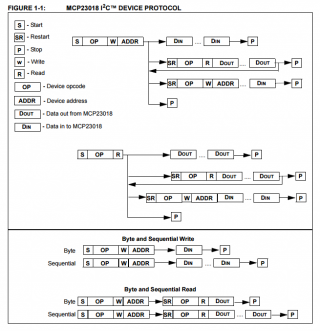I am trying to understand I/O expander datasheets.
Can you recommend a book or resource that explains I/O expanders and micro controllers so I can understand datasheets?
Take for example this one sentence from http://ww1.microchip.com/downloads/en/DeviceDoc/22103a.pdf 1.3.2.1 I2C Write Operation:

Nothing in Figure 1-1 is labeled "control byte" or "register address" and I don't know what they are.
I assume these are basic vocabulary because they are not defined in the datasheet.
Googling "I/O expander" "control byte" "register address sequence" only gets 8 results, all them datasheets.
Thank you.
Can you recommend a book or resource that explains I/O expanders and micro controllers so I can understand datasheets?
Take for example this one sentence from http://ww1.microchip.com/downloads/en/DeviceDoc/22103a.pdf 1.3.2.1 I2C Write Operation:
The I2C write operation includes the control byte and register address sequence, as shown in the bottom of Figure 1-1.

Nothing in Figure 1-1 is labeled "control byte" or "register address" and I don't know what they are.
I assume these are basic vocabulary because they are not defined in the datasheet.
Googling "I/O expander" "control byte" "register address sequence" only gets 8 results, all them datasheets.
Thank you.

